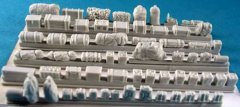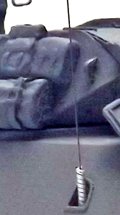Centurion Beach Armoured Recovery Vehicle (BARV) FV4108
The original BARVs were based on the Sherman III (M4A2) a total of 52 were available for the Normandy Invasion on D-Day where they proved to be of great value recovering vehicles broken-down or swamped in the surf and blocking access to the beaches. Due to time limitations these vehicles were not fitted with winches or earth anchors and were limited to pushing and pulling disabled vehicles and small Landing Craft such as the LCA, LCVP, etc., that had got stuck on the beach. They could operate up to a depth of 2.7 metres (9') with an 18inch surge. The vehicle included a diver in the crew, whose job was to attach towing chains to stuck vehicles. Developed and operated by the REME (Royal Electrical and Mechanical Engineers), the Sherman III was chosen, as being of welded construction, the waterproofing would be more successful than the other Marks available and as it was a powered by a diesel engine it was felt that it would be less affected by the greater temperature changes due to regular immersion into cold water. Some Sherman BARV's continued in service until 1963, when they were replaced by the Centurion version. By the late 1950s, Sherman BARV's were unable to recover the heavier AFV'S then being introduced. The Centurion BARV FV4018 was developed as a replacement with 12 vehicles converted Mark 1, 2, and 3 Centurion hulls that were already redundant. Initially given to the Army, they were then assigned to the Royal Marines in line with their newly acquired amphibious assault role. The Centurion BARV was similar to it's Sherman predecessor able to wade up to 3.4 metres (11') with an 18inch surge. The design was functional but simple with sloped armour built above the tank hull and retaining the gun-tank's Rolls-Royce Meteor petrol engine. Each BARV had a crew of four, including two from the REME, one of whom was a qualified diver and provided an essential role for the LPD's HMS Fearless & HMS Intrepid as part of the Beach Assault Squadrons. Initially the BAS was a mix of Royal Marines and Army serving aboard the ships but eventually they became all Royal Marines. The crew consisted of a sergeant, two corporals and marine all qualified vehicle mechanics. There are several Centurion BARV's surviving with the vehicle at AeroVenture's Falklands War Collection in Doncaster, BARV 02ZR77, being of special interest. This was originally one of the first Centurions ever built, somewhere between 1944 and 1946 and later converted into a BARV. It was one of the two BARV's that took part in Operation Sutton, the landings at San Carlos with one from HMS Fearless supporting the landings on Blue Beach and the other from HMS Intrepid supporting the landings on Red Beach. This vehicle remains the longest serving armoured vehicle ever in British service, finally leaving service in 2005 after taking part in both Gulf conflicts. Other countries that have used the Centurion BARV include Australia, Israel and the Netherlands. The Centurion BARV was finally replaced in British service by the Hippo BRV (Beach Recovery Vehicle).
- SKU: UK317
- Shipping info
We ship to all countries World Wide. If you receive an error message "No shipping location available" or similar, please contact us directly by e-mail (info@milicast.com) and we shall assist. Sorry for any inconvenience this may cause.
Shipments outside the UK may be subject to Duty & Taxes from the government of the destination country. Payment of Duty & Taxes are the responsibility of the customer.
- Payment methods

- Return Policy
We accept returns
The original BARVs were based on the Sherman III (M4A2) a total of 52 were available for the Normandy Invasion on D-Day where they proved to be of great value recovering vehicles broken-down or swamped in the surf and blocking access to the beaches. Due to time limitations these vehicles were not fitted with winches or earth anchors and were limited to pushing and pulling disabled vehicles and small Landing Craft such as the LCA, LCVP, etc., that had got stuck on the beach. They could operate up to a depth of 2.7 metres (9') with an 18inch surge. The vehicle included a diver in the crew, whose job was to attach towing chains to stuck vehicles. Developed and operated by the REME (Royal Electrical and Mechanical Engineers), the Sherman III was chosen, as being of welded construction, the waterproofing would be more successful than the other Marks available and as it was a powered by a diesel engine it was felt that it would be less affected by the greater temperature changes due to regular immersion into cold water. Some Sherman BARV's continued in service until 1963, when they were replaced by the Centurion version. By the late 1950s, Sherman BARV's were unable to recover the heavier AFV'S then being introduced. The Centurion BARV FV4018 was developed as a replacement with 12 vehicles converted Mark 1, 2, and 3 Centurion hulls that were already redundant. Initially given to the Army, they were then assigned to the Royal Marines in line with their newly acquired amphibious assault role. The Centurion BARV was similar to it's Sherman predecessor able to wade up to 3.4 metres (11') with an 18inch surge. The design was functional but simple with sloped armour built above the tank hull and retaining the gun-tank's Rolls-Royce Meteor petrol engine. Each BARV had a crew of four, including two from the REME, one of whom was a qualified diver and provided an essential role for the LPD's HMS Fearless & HMS Intrepid as part of the Beach Assault Squadrons. Initially the BAS was a mix of Royal Marines and Army serving aboard the ships but eventually they became all Royal Marines. The crew consisted of a sergeant, two corporals and marine all qualified vehicle mechanics. There are several Centurion BARV's surviving with the vehicle at AeroVenture's Falklands War Collection in Doncaster, BARV 02ZR77, being of special interest. This was originally one of the first Centurions ever built, somewhere between 1944 and 1946 and later converted into a BARV. It was one of the two BARV's that took part in Operation Sutton, the landings at San Carlos with one from HMS Fearless supporting the landings on Blue Beach and the other from HMS Intrepid supporting the landings on Red Beach. This vehicle remains the longest serving armoured vehicle ever in British service, finally leaving service in 2005 after taking part in both Gulf conflicts. Other countries that have used the Centurion BARV include Australia, Israel and the Netherlands. The Centurion BARV was finally replaced in British service by the Hippo BRV (Beach Recovery Vehicle).
- ManufacturerMilicast
- Unit of SaleSingle Unit
- Assembly StatusUnassembled Kit
- Scale1:76
- Age Level17 Years & Up
- Skill Level3 – Intermediate
- ThemeMilitaria
We ship to all countries World Wide. If you receive an error message "No shipping location available" or similar, please contact us directly by e-mail (info@milicast.com) and we shall assist. Sorry for any inconvenience this may cause.
Shipments outside the UK may be subject to Duty & Taxes from the government of the destination country. Payment of Duty & Taxes are the responsibility of the customer.
We accept the following payment methods:

To pay by credit or debit card, please select Stripe at checkout.
All Goods remain the property of Milicast Model Company until paid for in full. Goods may only be returned by prior arrangement at the recipients' expense. Delivery and insurance charges are non-refundable. Claims for damaged/missing items should be made within seven days of receipt.
Any products purchased 'second hand’, (without proof of direct Milicast Model Company supply, or supply from an Milicast Model Company approved dealer, shop or agent), or any products part assembled or part worked on in any way, are not covered by this returns policy. Under these circumstances no returns will be accepted, however we may quote for the supply of parts to restore the product to full inventory.






















